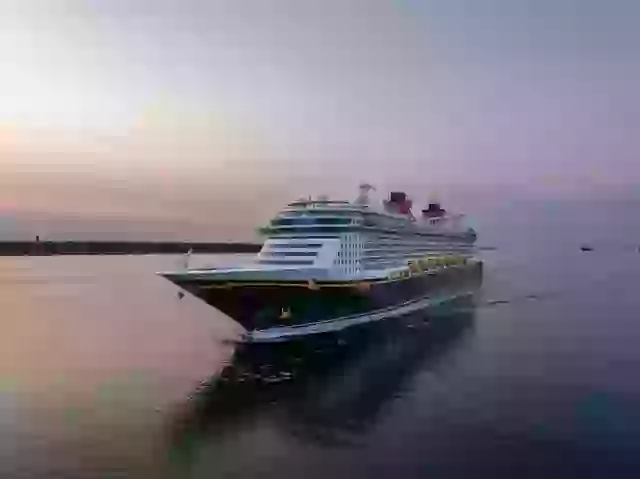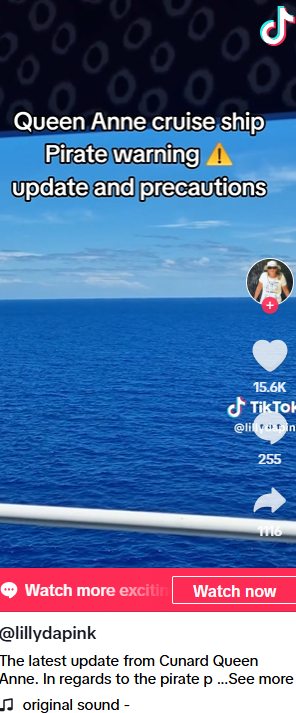What was meant to be a relaxing and luxurious voyage at sea took an unsettling turn for passengers aboard Cunard’s Queen Anne cruise ship, as travelers were suddenly instructed to dim their lights and close their curtains during a nighttime passage through a specific stretch of ocean. What unfolded in real time was a rare and nerve-wracking moment that revealed the unseen dangers of maritime travel, even in the modern era.
The instructions came not from speculation or rumor, but directly from the ship’s captain, whose announcement sent ripples of confusion and concern throughout the decks. The ship, which began its journey in Germany in January, was at that time navigating a leg of its route between Darwin, Australia, and Manila in the Philippines. While crossing the Sulu-Celebes Sea, an area known in maritime security circles for its history of pirate activity, guests were issued a very clear and specific warning.

The captain’s advisory, delivered via the ship’s public announcement system and later shared by a cruise and travel influencer on TikTok under the name @lillydapink, asked passengers to take immediate actions to reduce the vessel’s visibility. Guests were instructed to turn off cabin lights, draw all curtains, and limit exterior movement after dark to minimize exposure and maintain discretion as the ship sailed through these volatile waters.
In the video clip, the captain’s voice carries a calm but unmistakable gravity. He explains the implementation of visible safety measures, such as the setup of pressurized fire hoses lining the promenade decks, rigged and ready as a defensive precaution. These hoses, connected to high-pressure water nozzles, serve not only as a deterrent but also a protective line in the event of any close contact with unknown vessels.

While guests were reassured that the risk was low, the level of preparation sent a powerful message: the possibility, however slight, of encountering piracy in these waters remains something cruise lines take very seriously. The captain went on to warn guests of potential tripping hazards posed by the hose setup and announced the closure of Deck 3 from 9 PM to 5 AM, citing the necessity of darkness during that period for safety.
Additionally, with all external lighting turned off, passengers were urged to avoid walking around on upper open-air decks and instead stay within the ship’s interior. The cruise line’s cautious approach made it clear that even in today’s tech-saturated travel world, certain routes come with unique security considerations—particularly near regions where piracy has been documented.
Reactions online were a mix of surprise, fascination, and a dash of disbelief. Social media users who came across the video commented on the eerie nature of the experience, with one writing, “Well that sounds terrifying,” to which the original poster clarified that it was simply standard procedure and the risk remained minimal.
Another viewer expressed astonishment that piracy still exists in today’s world, admitting, “Idk why but every time I hear about real life pirates I’m always shocked/amazed that they really exist.” A former cruise ship employee even chimed in, recounting their own experiences of heightened security during sailings past Somali waters, sharing that armed security teams were sometimes brought aboard to ensure safe passage through those zones.
Although the risk of maritime piracy has been significantly reduced over the last decade in many high-alert areas due to international naval patrols and onboard security measures, regions like the Sulu-Celebes Sea still occasionally report suspicious maritime activity. The presence of organized pirate groups in some parts of Southeast Asia, particularly in the waters off the coasts of the southern Philippines, makes some shipping routes more vulnerable than others.

Still, cruise ships, unlike commercial cargo vessels, generally travel with extensive safety procedures and contingency plans. These include early threat detection protocols, rapid communication with coastal authorities, evasive maneuvers, and deterrents like non-lethal water cannons — all of which aim to de-escalate any potential encounter long before it becomes a direct threat.
In this case, the Queen Anne’s captain acted decisively, responsibly, and with the foresight needed to keep passengers not only safe but also aware. The transparent communication — amplified by the reach of social media — offered a rare glimpse into the less glamorous but highly important elements of cruise ship operations.
Passengers on board likely won’t forget the night they were told to draw the blinds, walk carefully around hose-rigged decks, and peer into the silent blackness of the sea with the knowledge that safety was being handled behind the scenes, long before it ever became a headline.